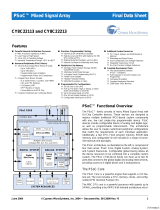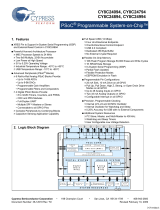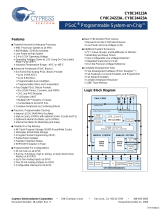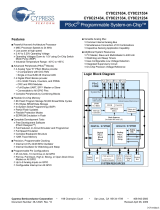Page is loading ...

User Interface - Keypad Scan, PSoC
®
Style
January 16, 2009 Document No. 001-40409 Rev. *A 1
AN2034
Author: Dave Van Ess
Associated Project: Yes
Associated Part Family: CY8C20x34, CY8C21x23, CY8C21x34
CY8C23x33, CY8C24x23A, CY8C24x94
CY8C27x43, CY8C29x66
GET FREE SAMPLES HERE
Software Version: PSoC Designer™ 5.0
Associated Application Notes: AN2354
Application Note Abstract
X–Y matrix keypads are an inexpensive interface enabling interaction with microcontroller-based products. This application
note shows how the PSoC® microcontroller’s unique I/O structure can build a keypad scan routine that is fast, uses minimal
RAM resources, and operates in a polled or interrupt mode. A function callable by either ‘C’ or assembly language is also
presented.
Introduction
An X-Y keypad enables use of N column lines and M row
lines to detect switch closures for N * M switches. For this
application note, a keypad is defined as an X-Y matrix
where only one key is pressed at a time, as opposed to a
keyboard where simultaneous key closures are the norm
([Ctrl] [Shift] [Delete]). This keypad definition is valid for
telephones, calculators, security entry kiosks, or other
products where only one key is pressed at a time.
This application relies on PSoC General Purpose Input
Output (GPIO).
Rows and Columns
This application note uses C columns and R rows. Figure
1 shows an example of such a keypad:
Figure 1. 4-Column by 4-Row Keypad
C
0
C
1
C
2
C
3
R
0
R
1
R
2
R
3
[0,0]
[0,1]
[0,2]
[0,3]
[1,1]
[1,0]
[1,2]
[1,3]
[2,0]
[2,1]
[2,2]
[2,3]
[3,0]
[3,1]
[3,2]
[3,3]
Closure of switch [i, j] (column i, row j) enables current
flow from row j to column i. This keypad requires only eight
connections to the MCU. The 16 diodes can detect
multiple key closures. However, because PSoC
microcontroller reduces the cost of external components
such as op-amps, filters, and DACs, using 16 diodes is not
a good idea.
Well known techniques have been developed to detect
multiple key presses without diodes. Figure 2 shows the
keypad without diodes.
Figure 2. The Keypad you can Afford
[0,0]
[0,1]
[0,2]
[0,3]
[1,1]
[1,0]
[1,2]
[1,3]
[2,0]
[2,1]
[2,2]
[2,3]
[3,0]
[3,1]
[3,2]
[3,3]
C
0
C
1
C
2
C
3
R
0
R
1
R
2
R
3
The standard algorithm for reading a keypad is to
individually drive each row and sample the status of all
columns. Correctly combining all this information enables
detection of at least two simultaneous switch closures.
The hardware cost is less but there is software overhead
required to scan all four rows, read column status, and
condense this information into an answer.
To develop a keypad scan that is low in both hardware
and software resources, limit its operation to single-key
presses.
[+] Feedback [+] Feedback

AN2034
January 16, 2009 Document No. 001-40409 Rev. *A 2
PSOC General Purpose IO
To detect single-switch closures, use the following
algorithm:
Drive all rows simultaneously and read the columns.
Drive all columns simultaneously and read the rows.
Condense this data to determine switch-closure
status.
The structure of the general purpose of each pin simplifies
this bipolar use of rows and columns. Each pin has a
digital driver that can be set up to be:
Strong drive to V
DD
and a pull down resistor to V
ss
.
Strong drive to V
ss
and a pull up resistor to V
DD
.
High Impedance
Strong drive to either V
DD
or V
ss
Use the pull down drive mode in the keypad scan routine,
as shown in Figure 3. Because it is also the default
condition for each pin at initial startup, there is no
requirement for special port configuration.
Figure 3. GPIO Set For Pull Down Mode
V
DD
pin
D
out
D
in
5.6 k
V
ss
Figure 4 shows implementation of a keypad scan.
Figure 4. PSoC Architecture for Keypad Scan
C
0
C
1
C
2
C
3
R
0
R
1
R
2
R
3
P
X.0
P
X.1
P
X.2
P
X.3
P
X.4
P
X.5
P
X.6
P
X.7
For this, press example switch [2,1] (column 2, row 1). The
algorithm reads the keypad in six steps.
1.
Output b00001111 to the port. This drives all the
rows high, leaving the columns passively pulled down.
2.
Read the port. The driven pins 0 through 3 remain
high and because the switch [2,1] is closed, pin 6 is
now high. The value read is b01001111.
3.
Output b11110000 to the port. This drives all the
columns high, leaving the rows passively pulled down.
4.
Read the port. The driven pins 4 through 7 remain
high and because the switch [2,1] is closed, pin 1 is
now high. The value read is b11110010.
5. “Anding” the result of step 2 and step 4 results in the
answer b01000010.
6. The upper 4 bits decode as column 2 and the lower 4
bits decode as row 1. This is a match with the closed
switch.
A subroutine that implements this algorithm is shown in
example Code 1. It enables the reading of a four row by
four column keypad connected to port 1. It is found in
“
Keypad.asm,” located in the project file associated with
this application note. This subroutine uses eight
instructions, 15 bytes of program memory bytes, and 57-
CPU cycles.
[+] Feedback [+] Feedback

AN2034
January 16, 2009 Document No. 001-40409 Rev. *A 3
Code 1: Subroutine for Reading Keypad
;-----------------------------------------
; Keypad.asm
;
; This routine reads a 4 column by 4 row
; keypad on port1. The status of key
; closures is returned in A.
;
; P1.4 P1.5 P1.6 P1.7
; C0 C1 C2 C3
; P1.0 R0 --+----+----+----+-
; | | | |
; P1.1 R1 --+----+----+----+-
; | | | |
; P1.2 R2 --+----+----+----+-
; | | | |
; P1.3 R3 --+----+----+----+-
;
;------------------------------------------
export bReadKeypad
export _bReadKeypad
include "m8c.inc"
bReadKeypad:
_bReadKeypad:
mov reg[PRT1DR], f0h ;drive columns
mov X,SP
mov A, reg[PRT1DR] ;read rows
mov reg[PRT1DR], 0fh ;drive rows
push A ;store row info on stack
mov A, reg[PRT1DR] ;Read Columns
and [X], A ;combine them
pop A
ret
The C header shown in example Code 2 can be found in
“
Keypad.h.” It makes the subroutine shown in example
Code 1 a ‘C’ callable function.
Code 2. C Header Example
// Create a pragma to support
// proper argument and return
// value passing
#pragma fastcall bReadKeypad
extern BYTE bReadKeypad(void);
Using the Output
The output of the function bReadKeypad is a single byte
that shows the status of key closure of the keypad. It is
translated and decoded as follows:
No bits are set if no key is pressed.
A single bit in the upper nibble and a single bit in the
lower nibble are set for a single-key press.
Any other condition is a multiple-key closure and is
defined as not valid.
These rules can be decoded with discrete conditional code
that breaks up the byte into two nibbles to determine row
and column information. Use this information to determine
which key, if any, was pressed. This results in a complex
set of rules and is tedious.
Another scheme is to use a lookup table to decode this
data. The advantage is that the table stores the formatted
data. Different programmers could be working on the
same project and each use their own table to decode the
keypad when they are required to read it.
The project file associated with this application note uses
such a table to decode the key closures. A block diagram
of the project is shown in
Figure 5.
Figure 5. Block Diagram for the Keypad Project
213
546
879
0*#
R
0
R
1
R
2
R
3
C
2
C
1
C
0
P
1.4
P
1.5
P
1.3
P
1.0
P
1.1
P
1.2
P
1.6
PSoC
MCU
b
c
a
g
d
f
e
P
0.6
P
0.5
P
0.4
P
0.3
P
0.2
P
0.1
P
0.0
V
dd
(common anode)
a cathode
b cathode
c cathode
d cathode
e cathode
f cathode
g cathode
MAN71A
For this project, set the drives for the port 1 pins to the Pull
Down mode (default) and the port 0 pins to either the Pull
Down or Strong mode.
The keypad is scanned and the appropriate bits are set on
the output port to turn on the desired LED segments. This
display is a single digit 7-segment common anode LED
display. Any particular segment is lit when its cathode is
pulled low. As an example, all output pins low result in an
“8” being displayed. All output pins high result in a blank
display.
[+] Feedback [+] Feedback

AN2034
January 16, 2009 Document No. 001-40409 Rev. *A 4
Example Code 3 is the main function that implements the
design in
Figure 5 on page 3.
Code 3. Keypad Project Implemented
;-----------------------------------------
; This program reads the keypad
; at port 1 and control the LEDs
; on port0.
;
; Copyright (c)
; Cypress Semiconductor 2002-2008.
; All Rights Reserved.
;------------------------------------------
include "m8c.inc"
export _main
_main:
loop:
call bReadKeypad
index KeyToLED
mov reg[PRT0DR], A
jmp loop
ret
xxh: equ 30h ;illegal character “E”
.Literal
KeyToLED:
db 7fh,xxh,xxh,xxh,xxh,xxh,xxh,xxh
db xxh,xxh,xxh,xxh,xxh,xxh,xxh,xxh
db xxh,4fh,4ch,xxh,0fh,xxh,xxh,xxh
db 78h,xxh,xxh,xxh,xxh,xxh,xxh,xxh
db xxh,12h,24h,xxh,00h,xxh,xxh,xxh
db 01h,xxh,xxh,xxh,xxh,xxh,xxh,xxh
db xxh,xxh,xxh,xxh,xxh,xxh,xxh,xxh
db xxh,xxh,xxh,xxh,xxh,xxh,xxh,xxh
db xxh,06h,20h,xxh,04h,xxh,xxh,xxh
db 18h,xxh,xxh,xxh,xxh,xxh,xxh,xxh
db xxh,xxh,xxh,xxh,xxh,xxh,xxh,xxh
db xxh,xxh,xxh,xxh,xxh,xxh,xxh,xxh
db xxh,xxh,xxh,xxh,xxh,xxh,xxh,xxh
db xxh,xxh,xxh,xxh,xxh,xxh,xxh,xxh
db xxh,xxh,xxh,xxh,xxh,xxh,xxh,xxh
db xxh,xxh,xxh,xxh,xxh,xxh,xxh,xxh
.EndLiteral
The “.Literal” and “.EndLiteral” macros are used to disable
the compiler’s code compression algorithms so that the
literal information in the KeyToLED table is not
compressed.
This code can also be found in the project associated with
this application note. The table makes for a simple
translation from key press to displayed character. Develop
your own table for a particular application.
Debouncing
Debouncing solutions are specific to each system’s
program structure and switch selection. However,
debouncing is simple; it requires two sequential keypad
scans to agree for the scan to be valid.
Interrupt Driven Keypad Scans
Execute the following steps for an interrupt-instigated key
scan:
Configure the lower four (row) pins to be I/O interrupts
on a rising edge.
Set the upper four (column) pins high.
Write an interrupt handler that calls bReadKeypad.
Enable the GPIO interrupt.
The row pins stay low until a key press connects a column
to a row causing an interrupt.
One possible application is a security gate keypad reader
where the MCU is placed in the power-saving-sleep mode.
When someone presses a key, the processor wakes up
and decodes the user’s input. After finishing, the MCU can
put itself back to sleep. For more information about sleep
mode operation please refer to application note AN2354.
Summary
The PSoC microcontroller GPIO structure is ideal for fast
keypad scans. The “index” instruction enables simple
translation key presses to a user’s desired format. The
GPIO to interrupts makes for an interrupt-driven keypad
scan.
[+] Feedback [+] Feedback

AN2034
January 16, 2009 Document No. 001-40409 Rev. *A 5
Document History
Document Title: User Interface – Keypad Scan, PSoC
®
Style
Document Number: 001-40409
Revision ECN Orig. of
Change
Submission
Date
Description of Change
** 1532004 OGNE 10/02/07 New publication of existing application note.
*A 2640952 JVY 01/20/09 Updated content.
Added part numbers CY8C20x34, CY8C21x23, CY8C21x34,
CY8C23x33, CY8C24x23A, CY8C24x94, CY8C27x43, and CY8C29x66.
In March of 2007, Cypress recataloged all of its Application Notes using a new documentation number and revision code. This new documentation
number and revision code (001-xxxxx, beginning with rev. **), located in the footer of the document, will be used in all subsequent revisions.
PSoC is a registered trademark of Cypress Semiconductor Corp. "Programmable System-on-Chip," PSoC Designer, and PSoC Express are trademarks
of Cypress Semiconductor Corp. All other trademarks or registered trademarks referenced herein are the property of their respective owners.
Cypress Semiconductor
198 Champion Court
San Jose, CA 95134-1709
Phone: 408-943-2600
Fax: 408-943-4730
http://www.cypress.com/
© Cypress Semiconductor Corporation, 2002-2009. The information contained herein is subject to change without notice. Cypress Semiconductor
Corporation assumes no responsibility for the use of any circuitry other than circuitry embodied in a Cypress product. Nor does it convey or imply any
license under patent or other rights. Cypress products are not warranted nor intended to be used for medical, life support, life saving, critical control or
safety applications, unless pursuant to an express written agreement with Cypress. Furthermore, Cypress does not authorize its products for use as
critical components in life-support systems where a malfunction or failure may reasonably be expected to result in significant injury to the user. The
inclusion of Cypress products in life-support systems application implies that the manufacturer assumes all risk of such use and in doing so indemnifies
Cypress against all charges.
This Source Code (software and/or firmware) is owned by Cypress Semiconductor Corporation (Cypress) and is protected by and subject to worldwide
patent protection (United States and foreign), United States copyright laws and international treaty provisions. Cypress hereby grants to licensee a
personal, non-exclusive, non-transferable license to copy, use, modify, create derivative works of, and compile the Cypress Source Code and derivative
works for the sole purpose of creating custom software and or firmware in support of licensee product to be used only in conjunction with a Cypress
integrated circuit as specified in the applicable agreement. Any reproduction, modification, translation, compilation, or representation of this Source
Code except as specified above is prohibited without the express written permission of Cypress.
Disclaimer: CYPRESS MAKES NO WARRANTY OF ANY KIND, EXPRESS OR IMPLIED, WITH REGARD TO THIS MATERIAL, INCLUDING, BUT
NOT LIMITED TO, THE IMPLIED WARRANTIES OF MERCHANTABILITY AND FITNESS FOR A PARTICULAR PURPOSE. Cypress reserves the
right to make changes without further notice to the materials described herein. Cypress does not assume any liability arising out of the application or
use of any product or circuit described herein. Cypress does not authorize its products for use as critical components in life-support systems where a
malfunction or failure may reasonably be expected to result in significant injury to the user. The inclusion of Cypress’ product in a life-support systems
application implies that the manufacturer assumes all risk of such use and in doing so indemnifies Cypress against all charges.
Use may be limited by and subject to the applicable Cypress software license agreement.
[+] Feedback [+] Feedback
/









